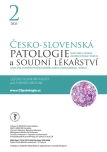Bleeding after childbirth / miscarriage - practical notes on the examination of biopsy material
Authors:
Šárka Hadravská 1,2; Vladimír Korečko 3; Magdaléna Daumová 1,2
Authors‘ workplace:
Šiklův ústav patologie LFP UK a FN Plzeň
1; Bioptická laboratoř s. r. o., Plzeň
2; Gynekologicko-porodnická klinika LFP UK a FN Plzeň
3
Published in:
Čes.-slov. Patol., 59, 2023, No. 2, p. 55-59
Category:
Reviews Article
Overview
Postpartum haemorrhage is a significant cause of maternal morbidity and mortality worldwide. The pathologist encounters only a limited spectrum of causes leading to postpartum haemorrhage. The most common causes are retained placenta and placental site subinvolution. Both of these lesions can be diagnosed from material obtained by uterine curettage. Morbidly adherent placenta (placenta accreta spectrum) is a less frequent subject of investigation, the diagnosis of which can be reliably established only on the basis of histological examination of uterine specimens after hysterectomy.
Keywords:
Postpartum hemorrhage – placenta accreta spectrum – retained placenta – placental site subinvolution
Sources
1. Hancock A, Weeks AD, Lavender DT. Is accurate and reliable blood loss estimation the ‘crucial step’ in early detection of postpartum haemorrhage: an integrative review of the literature. BMC Pregnancy Chilbirth 2015; 15): 230.
2. Carroli G, Cuesta C, Abalos E, Gulmezoglu AM. Epidemiology of postpartum haemorrhage: a systematic review. Best Pract Res Clin Obstet Gynaecol 2008; 22(6): 999-1012.
3. Lu MC, Fridman M, Korst LM, et al. Variations in the incidence of postpartum hemorrhage across hospitals in California. Matern Child Health 2005; 9(3): 297-306.
4. Callaghan WM, Kuklina EV, Berg CJ. Trends in postpartum hemorrhage: United States, 1994-2006. Am J Obstet Gynecol 2010; 202(4): 353 e351-356.
5. Kramer MS, Berg C, Abenhaim H, et al. Incidence, risk factors, and temporal trends in severe postpartum hemorrhage. Am J Obstet Gynecol 2013; 209(5): 449 e441-447.
6. Ramanathan G, Arulkumaran S. Postpartum hemorrhage. J Obstet Gynaecol Can 2006; 28(11): 967-973.
7. Weeks AD. The retained placenta. Best Pract Res Clin Obstet Gynaecol 2008; 22(6): 1103 - 1117.
8. Cheung WM, Hawkes A, Ibish S, Weeks AD. The retained placenta: historical and geographical rate variations. J Obstet Gynaecol 2011; 31(1): 37-42.
9. Khong TY, Khong TK. Delayed postpartum hemorrhage: a morphologic study of causes and their relation to other pregnancy disorders. Obstet Gynecol 1993; 82(1): 17-22.
10. Coviello EM, Grantz KL, Huang CC, Kelly TE, Landy HJ. Risk factors for retained placenta. Am J Obstet Gynecol 2015; 213(6): 864 e861 - 864 e811.
11. Endler M, Saltvedt S, Cnattingius S, Stephansson O, Wikstrom AK. Retained placenta is associated with pre-eclampsia, stillbirth, giving birth to a small-for-gestational - age infant, and spontaneous preterm birth: a national register-based study. BJOG 2014; 121(12): 1462-1470.
12. Endler M, Grunewald C, Saltvedt S. Epidemiology of retained placenta: oxytocin as an independent risk factor. Obstet Gynecol 2012; 119(4): 801-809.
13. Endler M, Saltvedt S, Papadogiannakis N. Macroscopic and histological characteristics of retained placenta: A prospectively collected case-control study. Placenta 2016; 41): 39 - 44.
14. Weydert JA, Benda JA. Subinvolution of the placental site as an anatomic cause of postpartum uterine bleeding: a review. Arch Pathol Lab Med 2006; 130(10): 1538-1542.
15. Kavalar R, Arko D, Fokter Dovnik N, Takac I. Subinvolution of placental bed vessels: case report and review of the literature. Wien Klin Wochenschr 2012; 124(19-20): 725-730.
16. Costa MA, Calejo LI, Martinez-de-oliveira J, Laurini R. Late-onset postpartum hemorrhage from placental bed subinvolution: a case report. J Reprod Med 2005; 50(7): 557 - 560.
17. Lyall F. Priming and remodelling of human placental bed spiral arteries during pregnancy - a review. Placenta 2005; 26 Suppl A): S31 - 36.
18. Al-Mehaisen L, Al-Kuran O, Amarin ZO, Matalka I, Beitawi S, Muhtaseb A. Secondary postpartum hemorrhage following placental site vessel subinvolution: a case report. Arch Gynecol Obstet 2008; 278(6): 585-587.
19. Khong TY, Abdul Rahman H. Bcl-2 expression delays postpartum involution of pregnancy - induced vascular changes in the human placental bed. Int J Gynecol Pathol 1997; 16(2): 138-142.
20. Morlando M, Collins S. Placenta Accreta Spectrum Disorders: Challenges, Risks, and Management Strategies. Int J Womens Health 2020; 12): 1033-1045.
21. Jauniaux E, Ayres-de-Campos D, Langhoff - Roos J, et al. FIGO classification for the clinical diagnosis of placenta accreta spectrum disorders. Int J Gynaecol Obstet 2019; 146(1): 20-24.
22. Hecht JL, Baergen R, Ernst LM, et al. Classification and reporting guidelines for the pathology diagnosis of placenta accreta spectrum (PAS) disorders: recommendations from an expert panel. Mod Pathol 2020; 33(12): 2382-2396.
23. Wu S, Kocherginsky M, Hibbard JU. Abnormal placentation: twenty-year analysis. Am J Obstet Gynecol 2005; 192(5): 1458-1461.
24. Silver RM, Landon MB, Rouse DJ, et al. Maternal morbidity associated with multiple repeat cesarean deliveries. Obstet Gynecol 2006; 107(6): 1226-1232.
25. Tantbirojn P, Crum CP, Parast MM. Pathophysiology of placenta creta: the role of decidua and extravillous trophoblast. Placenta 2008; 29(7): 639-645.
26. Gargett CE, Nguyen HP, Ye L. Endometrial regeneration and endometrial stem/progenitor cells. Rev Endocr Metab Disorder 2012; 13(4): 235-251
. 27. Laban M, Ibrahim EA, Elsafty MS, Hassanin AS. Placenta accreta is associated with decreased decidual natural killer (dNK) cells population: a comparative pilot study. Eur J Obstet Gynecol Reprod Biol 2014; 181): 284 - 288.
28. Schwede S, Alfer J, von Rango U. Differences in regulatory T-cell and dendritic cell pattern in decidual tissue of placenta accreta/ increta cases. Placenta 2014; 35(6): 378-385.
29. Gellersen B, Brosens IA, Brosens JJ. Decidualization of the human endometrium: mechanisms, functions, and clinical perspectives. Semin Reprod Med 2007; 25(6): 445-453.
30. Bailit JL, Grobman WA, Rice MM, et al. Morbidly adherent placenta treatments and outcomes. Obstet Gynecol 2015; 125(3): 683-689.
Labels
Anatomical pathology Forensic medical examiner ToxicologyArticle was published in
Czecho-Slovak Pathology

2023 Issue 2
Most read in this issue
- Hydatidiform mole
- Spontaneous abortion in the first trimester of pregnancy
- Skeletal dysplasias of the fetus and infant: comprehensive review and our experience over a 10-year period
- Molecular diagnosis of complete and partial hydatidiform moles
